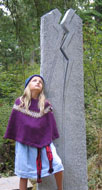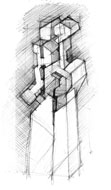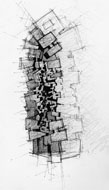- Details
-
Created: Tuesday, 02 May 2006 06:49
Nightmares in the Sky
by Stephen King, text, and f-stop Fitzgerald, photographs
 My impression of gargoyles was dramatically changed when our local librarian handed me Nightmares in the Sky. I had gone in search of pictures for inspiration in designing a logo for T-shirts for our recent hand carving workshop on San Juan Island. Our working subject was to be gargoyles in limestone. In this large book the beautiful photographs by f-stop Fitzgerald are of details on old buildings in Philadelphia, New York City, Chicago, Milwaukee and Washington, D.C. The text is by Stephen King, the undisputed master of the modern horror tale. Nightmares provided images that helped in the creation of the Greenman logo that graces our Roche Harbor Ts.
My impression of gargoyles was dramatically changed when our local librarian handed me Nightmares in the Sky. I had gone in search of pictures for inspiration in designing a logo for T-shirts for our recent hand carving workshop on San Juan Island. Our working subject was to be gargoyles in limestone. In this large book the beautiful photographs by f-stop Fitzgerald are of details on old buildings in Philadelphia, New York City, Chicago, Milwaukee and Washington, D.C. The text is by Stephen King, the undisputed master of the modern horror tale. Nightmares provided images that helped in the creation of the Greenman logo that graces our Roche Harbor Ts.
Stephen King recalls his first encounter with a gargoyle. “He takes me to the window, small, dirty, crisscrossed with old chicken wire and points across the street to something which seems to be a monster being born not of a living creature but of a building. Seeing this obscene thing is a shock; what is worse is seeing the people passing to and fro beneath it, intent on either plotting their day's business or planning their evening's pleasure; they pass to and fro and do not look up.
None of them look up.
I hear him say it again. ‘We don't see them...but they see us.’”
The first gargoyles were nothing but ornate gutters. The word itself comes from the Latin meaning drain or gutter or gullet. Wealthy folks and rich churches in medieval times competed to own the best and fanciest gargoyles.
King writes:
“...and yet the origin of the beast is enlightening, because it points directly to the purpose of the art-form. A drain is a perfectly utilitarian device for venting waste-water; gargoyles, with their dreamlike, hideous array of faces, may well serve much the same purpose for our minds: as a way of venting the mental waste material made up of our hidden fears, inadequacies, and even our unrealized and mostly unacknowledged aggressions...
You might note, as you leaf through these pages, how many of these beasts are seemingly insane with rage. Look closely, because we see these ominous Lares of the human psyche so seldom. They are there, these nightmares, but they are in the sky. Look closely, because even when you don't see them...
...they are watching you.”
As you can imagine, this book holds many fascinating images as well as a very provocative text.
- Details
-
Created: Friday, 02 June 2006 06:05
 I keep thinking I’ll run out of ideas for this column, but so far it hasn’t happened. If you use felt for the bottom of your pieces, don’t use household cement unless you invert the sculpture until it dries. The glue may wick through the felt before it’s dry and onto your nice varnished coffee table. Don’t be impatient to show off your efforts. Check for hardened glue that might cause scratches.
I keep thinking I’ll run out of ideas for this column, but so far it hasn’t happened. If you use felt for the bottom of your pieces, don’t use household cement unless you invert the sculpture until it dries. The glue may wick through the felt before it’s dry and onto your nice varnished coffee table. Don’t be impatient to show off your efforts. Check for hardened glue that might cause scratches.
Ziploc bags can be used conveniently in a tool box to hold small grinder blades and their adapters, sanding discs, carving bits. A copper pipe section can be capped on one end (soldered) and flared on the other to fit in a hole in a rock to create a watertight place for a few flower stems: voila, an attractive vase out of a scrap.
Sorting through old sculpture magazines I saw some sculptures that created mass by cementing granite countertop scraps together. They were mostly for bases, but some had been carved as part of the sculpture. Small pieces, which I find to be tippy on the table, can be pinned to a small base (kinda like ballast) using a nail, with holes in the base and sculpture serving as sleeves. I generally glue it into one or the other to avoid loss.
I employed Elaine’s “Stonehenge” insert concept with some other ideas in my two “Bubbles” pieces. I couldn’t get the black silicone technique to work with the thicker ones. The black slate discs are held in place with black plastic irrigation tubing used as o-rings, pressured and greased into grooves in both the slate and alabaster. The gap is 1/8”-3/16”. The orange discs are secured in the approximate 1/16” opening by friction on 2mm foam sheets (available in the craft department of Joanne’s ETC) cut to about half inch strips and wrapped around the discs, then slid into the holes with some lanolin greasing the way. After the first try I put contact paper around the outside of the hole’s opening to avoid scratching the alabaster. Cutesy pieces - but my inventiveness has been satisfied for awhile.
 Once in a while I'll draw a plan for a sculpture and get excited and say, "This is it - just do it!" But the stone has its own realities. The mass and weight and stoniness of the stone ask me to relate to it directly and draw on the stone, to cut it and feel it and look at it as it changes. However, drawing on paper is fun and it gives me a good excuse to sit down and drink a cup of coffee and listen to music on a cold day.
Once in a while I'll draw a plan for a sculpture and get excited and say, "This is it - just do it!" But the stone has its own realities. The mass and weight and stoniness of the stone ask me to relate to it directly and draw on the stone, to cut it and feel it and look at it as it changes. However, drawing on paper is fun and it gives me a good excuse to sit down and drink a cup of coffee and listen to music on a cold day. Here are a drawings that work around the question of how light moves through a column of stone. These drawings led to the creation of Mountain and Sky, respond to it and spin off into new territory.
Here are a drawings that work around the question of how light moves through a column of stone. These drawings led to the creation of Mountain and Sky, respond to it and spin off into new territory.

 My impression of gargoyles was dramatically changed when our local librarian handed me Nightmares in the Sky. I had gone in search of pictures for inspiration in designing a logo for T-shirts for our recent hand carving workshop on San Juan Island. Our working subject was to be gargoyles in limestone. In this large book the beautiful photographs by f-stop Fitzgerald are of details on old buildings in Philadelphia, New York City, Chicago, Milwaukee and Washington, D.C. The text is by Stephen King, the undisputed master of the modern horror tale. Nightmares provided images that helped in the creation of the Greenman logo that graces our Roche Harbor Ts.
My impression of gargoyles was dramatically changed when our local librarian handed me Nightmares in the Sky. I had gone in search of pictures for inspiration in designing a logo for T-shirts for our recent hand carving workshop on San Juan Island. Our working subject was to be gargoyles in limestone. In this large book the beautiful photographs by f-stop Fitzgerald are of details on old buildings in Philadelphia, New York City, Chicago, Milwaukee and Washington, D.C. The text is by Stephen King, the undisputed master of the modern horror tale. Nightmares provided images that helped in the creation of the Greenman logo that graces our Roche Harbor Ts. I keep thinking I’ll run out of ideas for this column, but so far it hasn’t happened. If you use felt for the bottom of your pieces, don’t use household cement unless you invert the sculpture until it dries. The glue may wick through the felt before it’s dry and onto your nice varnished coffee table. Don’t be impatient to show off your efforts. Check for hardened glue that might cause scratches.
I keep thinking I’ll run out of ideas for this column, but so far it hasn’t happened. If you use felt for the bottom of your pieces, don’t use household cement unless you invert the sculpture until it dries. The glue may wick through the felt before it’s dry and onto your nice varnished coffee table. Don’t be impatient to show off your efforts. Check for hardened glue that might cause scratches.